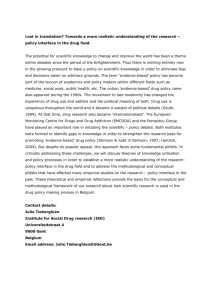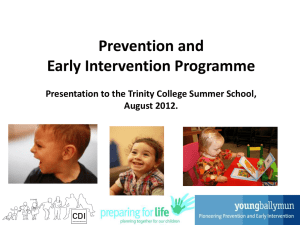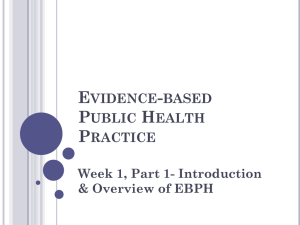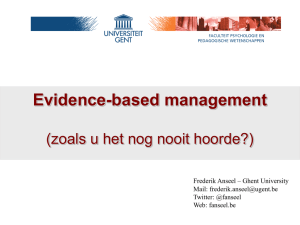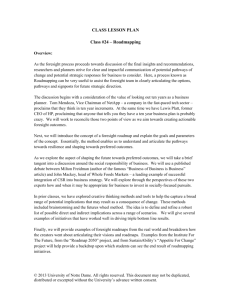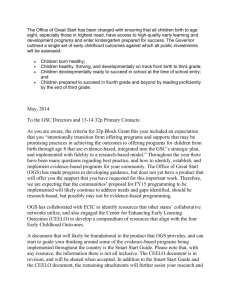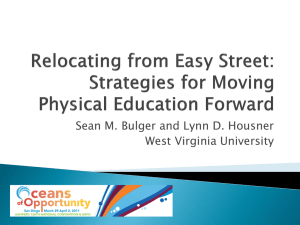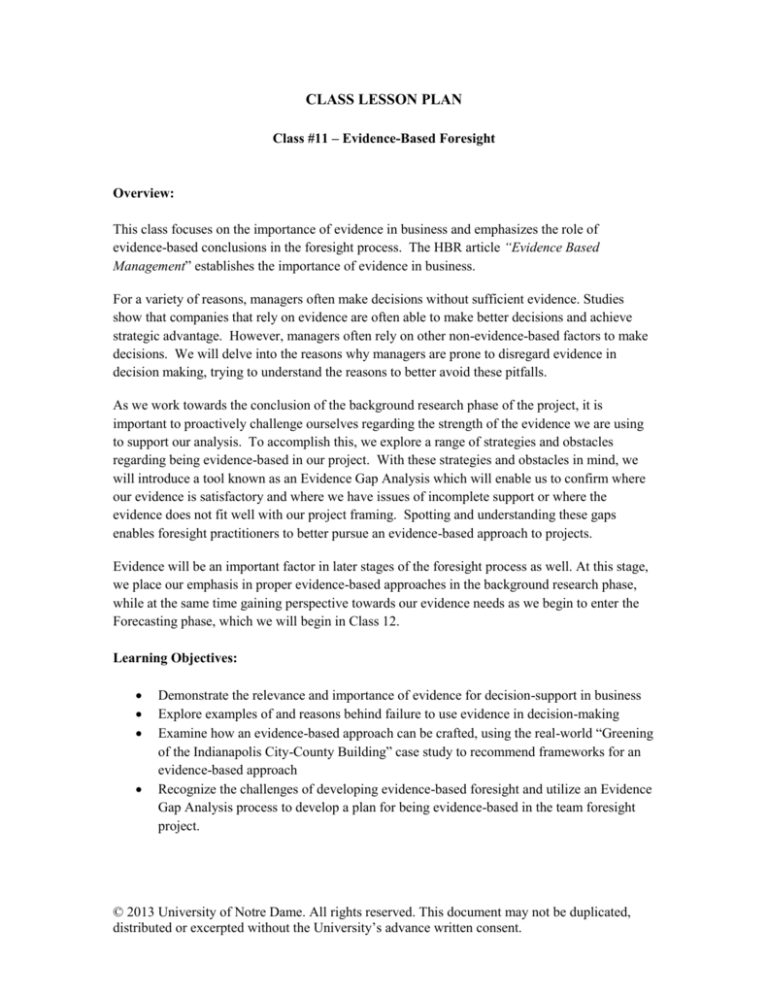
CLASS LESSON PLAN
Class #11 – Evidence-Based Foresight
Overview:
This class focuses on the importance of evidence in business and emphasizes the role of
evidence-based conclusions in the foresight process. The HBR article “Evidence Based
Management” establishes the importance of evidence in business.
For a variety of reasons, managers often make decisions without sufficient evidence. Studies
show that companies that rely on evidence are often able to make better decisions and achieve
strategic advantage. However, managers often rely on other non-evidence-based factors to make
decisions. We will delve into the reasons why managers are prone to disregard evidence in
decision making, trying to understand the reasons to better avoid these pitfalls.
As we work towards the conclusion of the background research phase of the project, it is
important to proactively challenge ourselves regarding the strength of the evidence we are using
to support our analysis. To accomplish this, we explore a range of strategies and obstacles
regarding being evidence-based in our project. With these strategies and obstacles in mind, we
will introduce a tool known as an Evidence Gap Analysis which will enable us to confirm where
our evidence is satisfactory and where we have issues of incomplete support or where the
evidence does not fit well with our project framing. Spotting and understanding these gaps
enables foresight practitioners to better pursue an evidence-based approach to projects.
Evidence will be an important factor in later stages of the foresight process as well. At this stage,
we place our emphasis in proper evidence-based approaches in the background research phase,
while at the same time gaining perspective towards our evidence needs as we begin to enter the
Forecasting phase, which we will begin in Class 12.
Learning Objectives:
Demonstrate the relevance and importance of evidence for decision-support in business
Explore examples of and reasons behind failure to use evidence in decision-making
Examine how an evidence-based approach can be crafted, using the real-world “Greening
of the Indianapolis City-County Building” case study to recommend frameworks for an
evidence-based approach
Recognize the challenges of developing evidence-based foresight and utilize an Evidence
Gap Analysis process to develop a plan for being evidence-based in the team foresight
project.
© 2013 University of Notre Dame. All rights reserved. This document may not be duplicated,
distributed or excerpted without the University’s advance written consent.
Key Terms and Concepts:
Evidence-based foresight
Substitutes for best evidence
Obstacles for being evidence-based
Strategies for becoming evidence-based
Evidence Gap Analysis
Preparation for Class:
Readings:
Pfeffer, J., & Sutton, R. I. (2006). Evidence-Based Management. Harvard Business
Review, 84(1), 62-74.
Discussion Questions:
1. Finish the following quote and discuss what it means: “If doctors practiced medicine like
many companies practice management, there would be …” Do you agree or disagree?
Why?
2. Briefly, what is the main thesis of this article?
3. The article mentions substitutes for best evidence commonly used by managers. What
are the substitutes for best evidence they define in the article? Why do managers (even
some smart ones) fall into the trap of using substitutes for best evidence?
4. As you dive into the background research phase of your foresight projects, you will
inevitably encounter challenges in being evidence-based. What factors do the authors
suggest make it hard to be evidence-based?
5. What strategies do the authors suggest for becoming evidence-based?
6. We break down the foresight process into the following phases: Scanning/Framing, Trend
Analysis/Forecasting, Strategic Implications, and Presentation of the Findings. Describe
how evidence can be useful in each of these phases.
Assignments Due:
Current Assessment Due ______________________.
Trend Analysis Strategy Due ______________________.
© 2013 University of Notre Dame. All rights reserved. This document may not be duplicated,
distributed or excerpted without the University’s advance written consent.
INSTRUCTOR GUIDELINES
Discussion Launchers:
This class begins with a class exercise on the Greening of the Indianapolis City County
Building. Start the class with an introductory video and get the teams directly into the
exercise. The middle portion of the class will be an interactive discussion towards the
teaching objectives. The final portion of the class will be another class exercise on
finding and resolving gaps in evidence for their team projects.
Discussion Questions with Answers:
1. Finish the following quote and discuss what it means: “If doctors practiced medicine like
many companies practice management, there would be …” Do you agree or disagree?
Why?
A: “If doctors practice medicine like many companies practice management, there would
be more unnecessarily sick or dead patients and many more doctors in jail or suffering
other penalties for malpractice” (48).
2. Briefly, what is the main thesis of this article?
A: “Managers can practice their craft more effectively if they are routinely guided by the
best logic and evidence - and if they relentlessly seek new knowledge and insight, from
both inside and outside their companies, to keep updating their assumptions, knowledge,
and skills” (49).
3. The article mentions substitutes for best evidence commonly used by managers. What
are the six substitutes they define and which of them do you think are most prevalent in
long term planning and decision-making (foresight)? Be ready to provide an example.
Why do managers (even some smart ones) fall into this trap of using substitutes for best
evidence?
A:
Obsolete knowledge / Past experience
Specialist skills
Hype and Marketing
Ideology (Dogma and Belief)
Uncritical emulation of top performers
4. As you begin the scanning, data collection and analysis phases of your foresight projects,
you will inevitably encounter challenges in being evidence-based. What factors do the
authors suggest make it hard to be evidence-based? How can your team overcome these
challenges?
A:
There’s too much information.
There’s not enough good evidence.
The evidence doesn’t quite apply.
People are trying to mislead you (It becomes difficult to discern good from bad
advice).
© 2013 University of Notre Dame. All rights reserved. This document may not be duplicated,
distributed or excerpted without the University’s advance written consent.
You are trying to mislead yourself by ignoring evidence that clashes with your
beliefs.
The side effects outweigh the cure.
Stories are more persuasive anyway
5. What strategies do the authors suggest for becoming evidence-based?
A:
There are four strategies suggested:
o Demand evidence – ask for research, pilot runs, reward learning, etc.
o Examine logic – pay attention to gaps in logic, inference, exposition.
o Treat organization as a prototype – run trial programs, experiments, etc.
o Embrace attitude of wisdom- healthy respect for and curiosity for an array of
knowledge.
6. We break down the foresight process into the following phases: Scanning/Framing, Trend
Analysis/Forecasting, Strategic Implications, and Presentation of the Findings. Describe
how evidence can be useful in each of these phases.
A: In scanning and framing, teams will benefit from using critical assessment of the
sources they scan, asking what evidence the source provides for support and how well
assumptions and logic are applied to the argument.
In trend analysis and forecasting, the challenge is for the students to effectively use
evidence (data) to analyze trends, and then use assumptions and logic to support their
projects of future change. It is essential that the assumptions and logic be both sound as
well as well-communicated to the reader in support of their arguments/conclusions.
In the implications assessment, it can be powerful to apply evidence from other situations
in which this type of change has occurred. Basing a potential implication of change in
this situation on an actual occurrence from a similar situation increases the plausibility
of this conclusion adds credibility to the argument.
Class Timeline:
10 Minutes – Intro and ESB video to launch class exercise
o Show the first 52 seconds of the SustainIndy video
o Show the full Empire State Building video
15 Minutes – Group exercise – Indy CCB planning charrette –
o Hand out case write up with role plays
o Have them discuss the options
o Instruct teams to identify four recommendations
10 Minutes – Student teams report out on their recommendation and supporting logic
15 Minutes – Interactive discussion around evidence-based case takeaways
5 Minutes – Intro and overview of Evidence Gap Analysis
20 Minutes – Team workshop time to perform Evidence Gap Analysis on their forces of
change
© 2013 University of Notre Dame. All rights reserved. This document may not be duplicated,
distributed or excerpted without the University’s advance written consent.
Classroom Activities/Short Assignments:
Class Activity – Indy Greening of the CCB exercise. Have students divide into groups
(not their project teams) and each take one role play handout for the Greening of the CCB
Planning Charrette. Have them take 15 minutes to discuss the project and work towards
four recommendations for the SustainIndy project leaders: “discuss recommendations for
the Indy CCB team to proceed in an evidence-based manner. Case study is provided.
Report out at end of exercise and write recommendations on the board, classifying them
into the four way to become evidence based from the HBR reading:
o Demand evidence
o Examine logic
o Treat the organization/project as an unfinished prototype (create evidence)
o Embrace the attitude of wisdom (keep an open mind)
Class Activity – Have project teams gather to initiate a discussion regarding gaps in their
supporting evidence for their foresight projects. Give them the Evidence Gap Analysis
worksheet and give them structured time to do a gap analysis. Ideally they identify gaps
in their supporting evidence (weak evidence / poor fit / incomplete evidence) and discuss
strategies and approaches they can use to overcome these gaps as they head towards their
Current Assessments in their foresight projects.
Multimedia Supplements:
o Greening of the Indianapolis City County Building
o Rocky Mountain Institute - Reinventing Fire Video
http://www.rmi.org/rmi/ReinventingFire Anthony Malkin segment @ 4:20-5:00
of video. (Use for instructor context rather than showing in class. We will use
this video for the Innovation-Based Response session in Module 3.)
© 2013 University of Notre Dame. All rights reserved. This document may not be duplicated,
distributed or excerpted without the University’s advance written consent.

